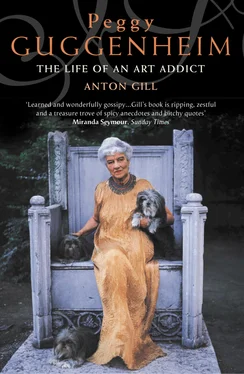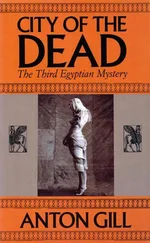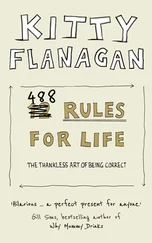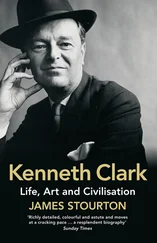Michael Cedric Sindbad Vail put in his appearance on 15 May 1923. Peggy nursed him for a month, until her milk gave out. A month later, she and Laurence were back in Paris with their little boy for the 14 July celebrations – a three-day binge for Laurence – which featured a drunken attack by Malcolm Cowley, Laurence and others on the unfortunate patron of the Rotonde. Once the partying and the vandalism were over, the Vails took a house in Normandy for the summer. Peggy missed Benita, who had returned to New York, but they had a constant stream of visitors, including Man Ray and Kiki; Harold Loeb; Clotilde and her latest lover; the poet Louis Aragon; and, on one occasion, James and Nora Joyce, en route to visit their daughter Lucia, who was attending a boarding school on the coast.
Their rootless life continued. Sindbad (as he came to be called – the name was Laurence’s choice), attended by an English nanny called Lilly who, Peggy noticed, had a magnetic effect on men, went with them. They travelled back to Capri in the autumn, where Laurence got into yet another fight, with a new lover of Clotilde’s, broke a policeman’s thumb and was sent to jail for ten days. Laurence’s bad behaviour, exacerbated by alcohol, continued throughout his life until age mellowed him; but he behaved, as far as one can judge, worse during his marriage to Peggy than at any other time. He constantly longed to get a reaction out of her, but she maintained an almost glacial and calculated indifference. It was however an indifference that extended to almost everything about her, as if she were watching life rather than participating in it; and though such an attitude was a fashionable pose at the time, Peggy was like a sleeping beauty, waiting to be woken up by the right stimulation. Laurence wasn’t her Prince Charming.
The Vails spent the winter in Egypt with just Lilly and Sindbad in attendance, and while Peggy followed the prevailing fashion and collected large numbers of pairs of earrings, a habit she never abandoned, Laurence bought himself brightly patterned bolts of cloth in the souks and had coats-of-many-colours made up. He also indulged himself, with Peggy’s consent, in a night with a Nubian belly-dancer who, he told her later, wore white underwear and ‘had a very high bed. When he could not climb up to it she took him under the armpits and lifted him up like a doll.’ She also gave him crabs, which not unnaturally horrified Peggy.
Apart from Laurence’s habitual tantrums and Peggy’s quibbling over money, this seems to have been a relatively happy period for the couple. Leaving Sindbad in a hotel with Lilly, they explored Upper Egypt before returning to Cairo and, again leaving Sindbad and Lilly, travelling to Jerusalem. Peggy had responded enthusiastically to ancient Egyptian art and architecture, but in Jerusalem she was repelled by the sight of Orthodox Jews at the Wailing Wall: ‘It mortified me to belong to my people. The nauseating sight of my compatriots [sic] publicly groaning and moaning and going into physical contortions was more than I could bear, and I was glad to leave the Jews again.’ In the New Year they returned at last to Paris, successfully smuggling in all the wares they had bought, together with a gigantic rag-doll stuffed with four hundred illegal Turkish cigarettes.
Owing to the arrival of Sindbad, the rooms at the Lutétia were now too small, and Peggy, whom motherhood suited when it suited her, had already promised Laurence ‘a girl next time’. The family moved to a rented apartment on the boulevard St Germain, at the heart of the Left Bank, appalling their aristocratic landlord by shifting all his good Louis XVI sofas, tables and chairs into a back room and replacing them with fashionable rustic French furniture. They stayed for six months through 1924, holding another round of wild parties, though this was seldom to Peggy’s liking. She was scared that some of the guests (Laurence, it will be remembered, tended to invite all and sundry) might make off with the silver, and she hated having to clean up people’s vomit the following day, or to change the sheets on her bed after someone else had made love in them. On the morning after she would purge the apartment, Lysol bottle in hand. Insult was added to injury by the fact that at the time Peggy scarcely drank; there can be nothing more boring to a non-drinker than a drunk, and she found herself frequently surrounded by them. For similar reasons, the long nights idling on the terraces of bars bored her to sleep.
Florette, back in Paris to hover over her daughter and grandchild, attended one or two of these parties, and on the whole enjoyed them, though she became enraged when Kiki once drunkenly called Man Ray ‘a dirty Jew’, and made her feelings known. By now she had made friends with Gertrude Vail, but the two women’s attempts to lure their married offspring back into the wealthy fold of the American colony in Paris came to nothing, though in the years to come Peggy accepted annual presents of either a fur coat or a new car from her mother, and noted gratefully that Florette was ‘forever putting money into trusts for me’.
Laurence encouraged Peggy to continue to shop at Poiret’s, and in 1924 she bought herself a flowing dress in Oriental style that she liked so much, now she had got her figure back after her pregnancy, that she wore it again and again. To go with it she had Stravinsky’s fiancée, Vera Sudeikin, design a golden turban. Man Ray took a series of photographs of her in it, which she adored. Except as a little girl, Peggy never looked more attractive. So pleased was she by the dress that she ordered one for Mary Reynolds too. Mary had by now become a good friend, and was a frequent guest at the Vails’ parties. She was enjoying a wild sex life, partying all the time, but such pastimes were soon to be brought to a halt by a closer encounter than hitherto with someone she already knew – Marcel Duchamp. Mary had been unable to get home after a party and spent the night with Duchamp, who generally disapproved of her way of life, but the next day, out of cash and unable to bring herself to ask him for more than 10 francs towards the fare she needed for a cab home, she called on Peggy to rescue her.
Throughout his life Duchamp was an é minence grise. Aged thirty-seven in 1924, he had returned to France a year earlier after three sojourns in the United States (he first visited New York in 1915), but though he aligned himself with the Surrealists, his work remained independent, and he was never a member of any specific artistic party. As much a theoretician as an artist, he had long since abandoned obviously creative work for chess, of which he was a master. Ascetic and essentially solitary by nature, his life would be bound up with Mary’s until she died, and his aesthetic influence on Peggy was to be profound.
In 1924 the cultural life of Paris was enriched when the Comte de Beaumont initiated a ballet series at La Cigale in Montmartre, producing work by Stravinsky, Milhaud, Honegger and Satie among others, with decors by Picasso, Ernst, Picabia and Miró. Peggy liked ballet, especially as a backdrop to socialising, but she was never much of a one for the performing arts, and the couple grew restless. She had her hair bobbed, which occasioned another outburst from Laurence, and then later in the spring another visit to Europe from Benita and Edward provided a welcome means of escape for a time. Peggy, with Florette in tow, joined her sister in Venice.
She had been there three times before on her trips through Europe with Laurence. Equipped with a little knowledge of her own, she proceeded to act as the family guide. At the end of spring she returned to Paris to find that Laurence had had an affair. His mistress had a baby nine months later, but Peggy reports that they never discovered whether it was Laurence’s doing or, rather improbably, Robert McAlmon’s, or – a welcome possibility – the woman’s husband’s. Peggy forgave Laurence, but the fighting went on as relentlessly as ever. Once, when they were staying at his mother’s flat, they yelled at each other so loudly that Clotilde came in from the next room, immediately took her brother’s part, and told Peggy to get out of the apartment. ‘I was so upset,’ said Peggy, ‘I began rushing around the flat as I was, quite naked.’ The situation was saved by the appearance of Gertrude, who said, ‘This is my apartment, not Clotilde’s, and you are not to leave.’
Читать дальше












